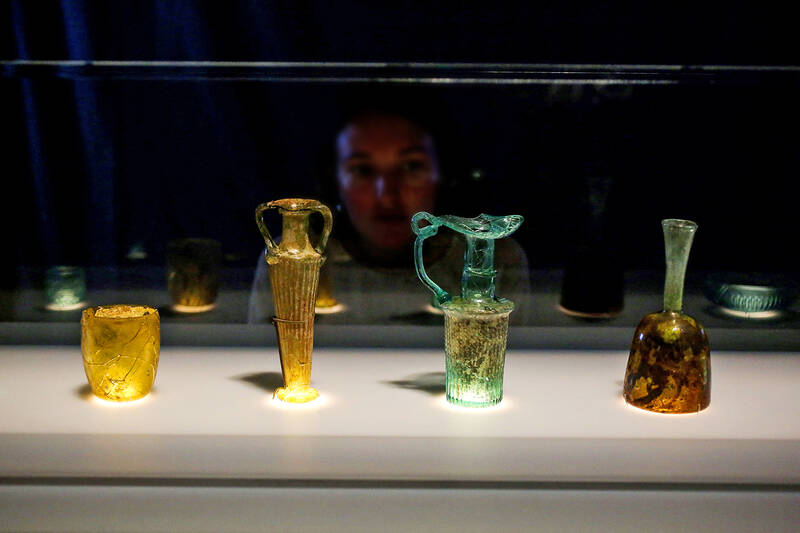Eight ancient glass vessels shattered in the 2020 Beirut explosion are going on display at the British Museum today, walking visitors through the painstaking international project to piece them back together.
The vessels, from the Roman, Byzantine and Islamic periods, were reconstructed at the world-famous museum’s conservation laboratories, and will be shown as part of its “Shattered Glass of Beirut” showcase, before returning to Lebanon later this year.
“(It) tells a story of near destruction and recovery, of resilience and collaboration,” said Hartwig Fischer, Director of the British Museum.

Photo: AFP
The vessels were among 74 contained within a case at the American University in Beirut (AUB). The case fell over when the shockwave of the port blast, which occurred three kilometres away on August 4, 2020, hit the building, smashing the glass objects inside.
A team of experts had the daunting task of sorting every shard of glass, deciding if it was part of an ancient vessel, rather than display case, and which vessel it belonged to, Duygu Camurcuoglu, a senior conservator at the British Museum, said.
“It’s all pretty much done by hand or by eye — brainwork basically. You have to know certain techniques to be able to carry out this work,” she added.
Once the pieces had been sorted, the conservators began the mammoth jigsaw-puzzle exercise of reassembling the vessels.
“It’s a case of using an adhesive to reconstruct the vessels,” said Camurcuoglu. But they could not just use anything.
“We don’t use superglue, we don’t use UHU,” she joked.
The most challenging vessels were the “large dish and the Byzantine pitcher,” Camurcuoglu recalled.
Eighteen of the vessels have so far been conserved as part of an emergency recovery campaign in Beirut, along with the eight vessels at the British Museum and two that emerged unscathed from the fall. Experts hope that at least half of the remaining 46 objects in Beirut can be conserved soon too.
The collaborative project between the British Museum and the AUB’s Archaeological Museum began last year, following an offer of help from the London institution.
Conservators agreed early on to make the vessels structurally sound but leave imperfections caused by the shattering visible, bearing witness to the explosion. The exhibition will take visitors on the journey undergone by the glass vessels, from the moment of the blast to their display in the famous London museum. Lighting will be used in the display to illuminate cracks and gaps in the glass.
“We really wanted to highlight the damage these objects went through, so we can all look at the scars, and remember how they were revived together,” Camurcuoglu said.
The vessels are considered important in telling the story of the development of revolutionary glass-blowing techniques in Lebanon in the 1st century BC, enabling the mass production of glass objects and making them available for common use. Their restoration, and the teamwork involved, is a source of pride to the conservators, Camurcuoglu said.
“We all individually felt that, I think, we contributed to something by working on these objects — by sharing this pain, these emotions.
“So it’s not only about the conservation ... but also the working together and achieving something together,” she added.

On April 26, The Lancet published a letter from two doctors at Taichung-based China Medical University Hospital (CMUH) warning that “Taiwan’s Health Care System is on the Brink of Collapse.” The authors said that “Years of policy inaction and mismanagement of resources have led to the National Health Insurance system operating under unsustainable conditions.” The pushback was immediate. Errors in the paper were quickly identified and publicized, to discredit the authors (the hospital apologized). CNA reported that CMUH said the letter described Taiwan in 2021 as having 62 nurses per 10,000 people, when the correct number was 78 nurses per 10,000

May 5 to May 11 What started out as friction between Taiwanese students at Taichung First High School and a Japanese head cook escalated dramatically over the first two weeks of May 1927. It began on April 30 when the cook’s wife knew that lotus starch used in that night’s dinner had rat feces in it, but failed to inform staff until the meal was already prepared. The students believed that her silence was intentional, and filed a complaint. The school’s Japanese administrators sided with the cook’s family, dismissing the students as troublemakers and clamping down on their freedoms — with

As Donald Trump’s executive order in March led to the shuttering of Voice of America (VOA) — the global broadcaster whose roots date back to the fight against Nazi propaganda — he quickly attracted support from figures not used to aligning themselves with any US administration. Trump had ordered the US Agency for Global Media, the federal agency that funds VOA and other groups promoting independent journalism overseas, to be “eliminated to the maximum extent consistent with applicable law.” The decision suddenly halted programming in 49 languages to more than 425 million people. In Moscow, Margarita Simonyan, the hardline editor-in-chief of the

Six weeks before I embarked on a research mission in Kyoto, I was sitting alone at a bar counter in Melbourne. Next to me, a woman was bragging loudly to a friend: She, too, was heading to Kyoto, I quickly discerned. Except her trip was in four months. And she’d just pulled an all-nighter booking restaurant reservations. As I snooped on the conversation, I broke out in a sweat, panicking because I’d yet to secure a single table. Then I remembered: Eating well in Japan is absolutely not something to lose sleep over. It’s true that the best-known institutions book up faster